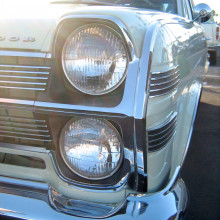What happens to light travelling at light speed?
We work out what would happen if you shone a light whilst travelling at light speed. Would you see anything? Would an observer see anything? Plus, we ask if dogs really can watch TV.
In this episode

00:00 - How fast does a moving light source go?
How fast does a moving light source go?
We posed this question to Dominic Ford from the University of Cambridge...
Dominic: - I'm Dominic Ford from the department of physics at Cambridge. You've probably had the experience at some point that a fire engine has driven past you and as the fire engine has been driving towards you, you've heard it sound high pitched. And as it's driven away from you, you've heard it sound low pitched. That happens because sound is a wave and the Doppler effect says that the frequency has changed when you are moving relative to the source of the sound.
Now light is also a wave and so, it also shows the Doppler effect. But you have to be travelling very much faster before you see any effect. So if you were driving your car at close to the speed of light, an external observer would see that your front headlights would appear more blue than normal and your rear taillights would appear more red than normal. The driver himself wouldn't actually see anything different from normal because he's not moving relative to the source of the light. Just as the driver of a fire engine hears his siren at a constant pitch because he's not moving relative to the siren. Looking out the window though, the driver would be moving relative to any landscape that he was moving past, and he would see objects in front of him appear bluer than normal and objects behind him appearing redder than normal.
Of course if things move very much faster, for example, a plane moving at close to the speed of sound, you get a sonic boom, and you get a similar effect with light. But unfortunately, Einstein's theory of special relativity says that you need infinite energy to make something move at the speed of light. And so, you can never actually get there and observe that effect.
There is one exception which is when a relativistic particle travels in a material like glass in which light travels at slightly less the speed of light - sounds ironic, but it's true! When the particle produces some radiation called Cherenkov radiation, which appears as a flash of light, the visual equivalent of a sonic boom. Diana: - To the driver, if he or she had infinite energy and hadn't imploded by then, the lights would look perfectly normal. To an observer, there would be a colour shift with blue headlights and red tail lights becoming more red if that's possible. And objects which do move faster than the speed of light will produce this Cherenkov effect, the sonic boom of the light world, and you can see it as a blue glow in some nuclear reactor chambers.





Comments
Add a comment